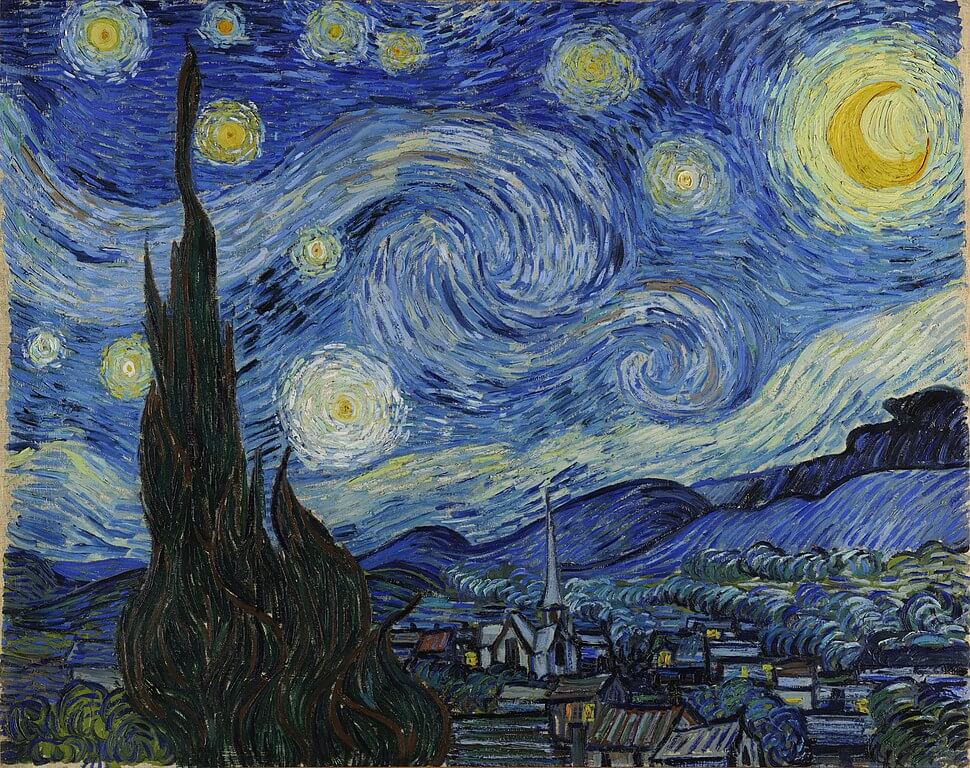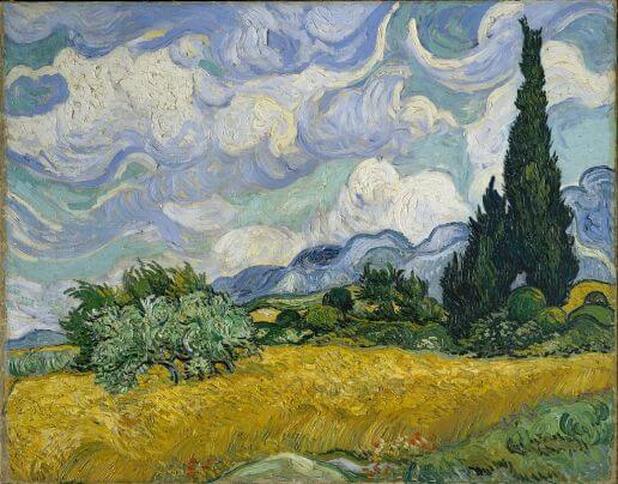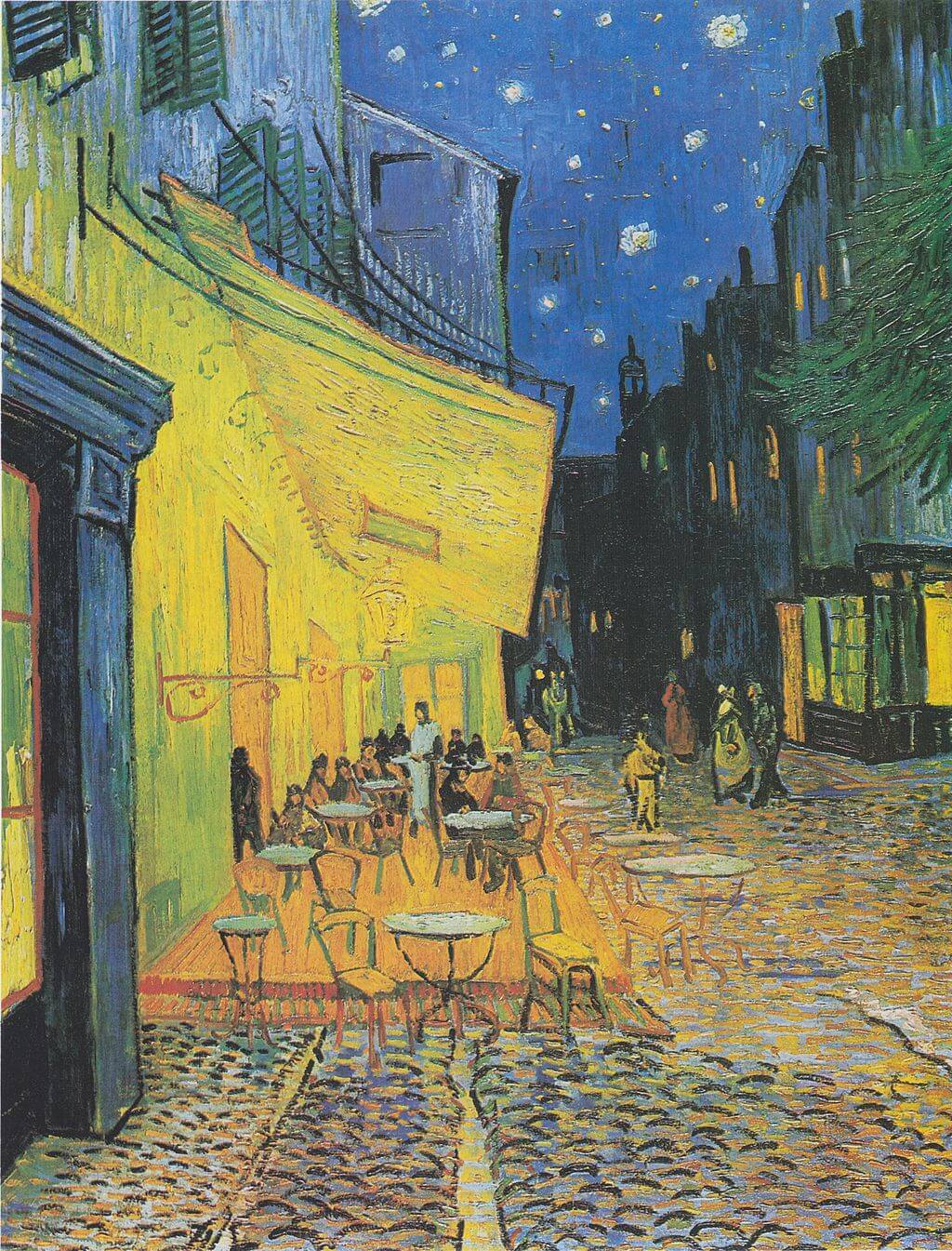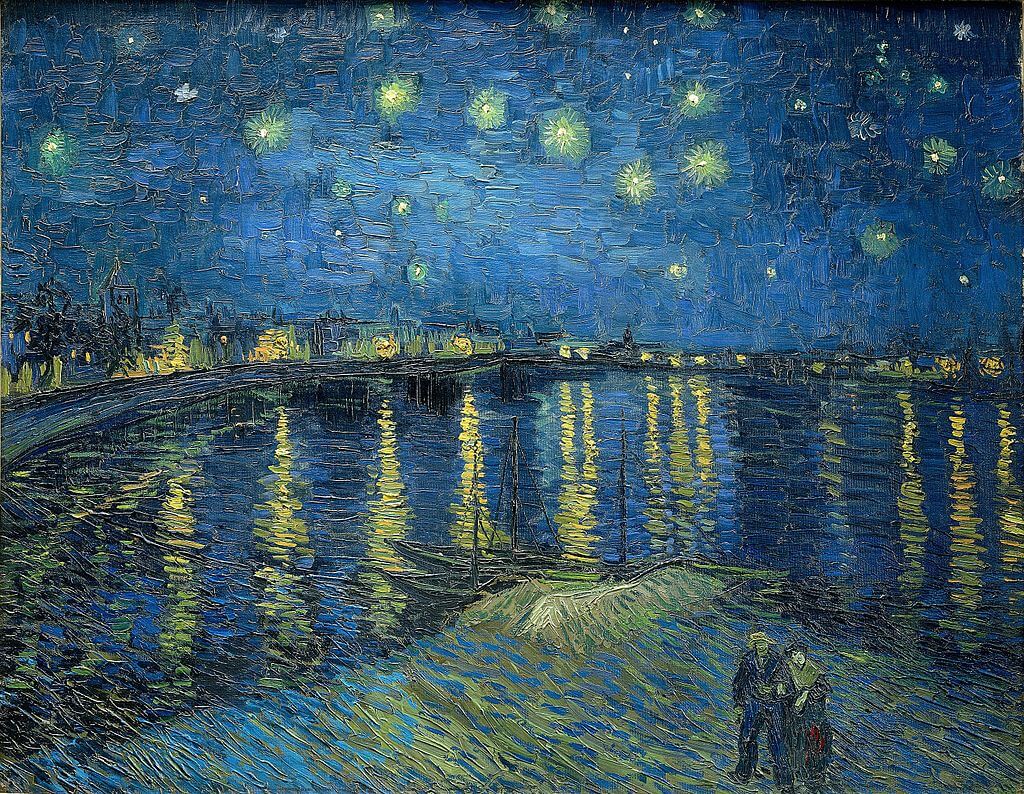|
Where? Floor 5, Gallery 1 of the Museum of Modern Art
When? June 1889 What do you see? This painting is an imaginative version of a starry night in Saint-Rémy in France where Van Gogh was staying at that time. The various elements in this painting are certainly inspired by what Van Gogh observed in reality, but he created his own ideal version of the starry night. In the painting, we can observe some trees, a village, and mountains under a night sky full of stars (or more precisely a collection of 12 celestial bodies). In the foreground, you can observe a big wavy cypress tree. The cypress is an element that comes back in multiple Van Gogh paintings, such as the Wheat Field with Cypresses in the Metropolitan Museum of Art. On the top right is a crescent moon. The brightest celestial body in the painting, just to the right of the cypress tree, is the planet Venus. The celestial bodies light up the sky (indicated by the use of white paint in the night sky). The church tower in the middle foreground is probably the Saint-Martin church in Saint-Rémy. Van Gogh, however, did not include the dome of the church in this painting. In the village surrounding the church, several houses still have their lights on. On the right side of the painting, between the village and the mountains, you can see a forest. The curvy lines used for the cypress tree and the clouds in the sky create a sense of movement in this painting. Notice also the clear contrast between the turbulent sky and the quiet life on earth. The cypress in the form of a big fire is the only element that connects the earth and sky with each other.
Backstory: The painting is created between June 16 and 18, 1889 when Van Gogh was staying in the hospital of Saint-Paul-de-Mausole at Saint-Rémy. In a letter to his brother Theo, he wrote: “This morning I saw the countryside from my window a long time before sunrise, with nothing but the morning star, which looked very big.” He mixed this view both with some other elements that he observed in the area of Saint-Rémy and his imagination to create this painting.
Van Gogh used thick broad strokes of oil paint to create this painting and it was probably created in a single day (even though the idea for this painting was already occupying his mind for over a year). If you look carefully, you can still see some pieces of the canvas in between the broad strokes of paint. Symbolism: There is some debate on whether this painting should be interpreted symbolically. One symbolic explanation for this painting centers around the cypress which connects the earth to the sky in this painting. The cypress tree is associated with cemeteries and death. In this painting, it could be the connection between life (which happens on earth) and death (which is when you go to the stars according to Van Gogh). Van Gogh wrote in one of his letters “We take death to go to a star.” Van Gogh, who would eventually commit suicide, was interested in death and he expressed some ideas that one would go to the stars after death. Other versions of the Starry Night? Van Gogh was already interested in the idea of painting a starry night in 1888 as expressed in several letters to his friends and brother. Indeed, in 1888 he painted two versions of a starry night. The first version is Café Terrace at Night which is in the Kröller-Müller Museum in The Netherlands. The second version is Starry Night over the Rhône which is in the Musée d’Orsay in Paris. However, these two paintings did not fulfill his idea of a perfect starry night. Instead of a starry night above a town, he was more interested in a starry night above a landscape and a more imaginative version of the night sky.
Who is Van Gogh? Vincent van Gogh (1853-1890) was born in Zundert in The Netherlands. At the end of his life, he created many paintings that fall under the Post-Impressionist style. Van Gogh has produced a large number of paintings during his life and most of them have been painted in the last two years of his life.
Vincent van Gogh wrote many letters during his life -- many of which to his brother Theo -- which have been saved. In these letters, he explained his ideas about painting and they form a valuable source to interpret his works. The work of Van Gogh was not really appreciated during his life, but his work has become famous after his suicide in 1890. Fun fact: While this is nowadays considered to be one of the best paintings by Vincent van Gogh, he did not seem very proud of this painting. When he wrote a letter to his brother Theo after he left Saint-Rémy, he did not mention this painting as a good one. In fact, he listed several paintings, including the Wheatfield with Cypresses, as “a little good.” About the other paintings from that period, including this painting, he writes “the rest says nothing to me.” His brother Theo seemed to agree that The Starry Night is not his best work. He was worried about the more imaginary nature of this work compared to the somewhat more realistic paintings he created before. He advised Vincent to stick to still lifes and flowers as that would have more therapeutic value for the mentally troubled Vincent.
Written by Eelco Kappe
References:
4 Comments
Madwand
9/7/2022 12:28:32 am
The cypress applauds the show in dark shadows watching the spector weave between the stars performing its nightly dance with its arm curling out searching for souls to capture.
Reply
Charles Cheng
8/15/2023 10:00:40 am
Dear Friend of van Gogh
Charles Cheng
8/15/2023 10:06:06 am
Dear Friend, there are 12 stars in the picture, the previous "Starry Night over the River of Rhone" has 11.
Reply
Leave a Reply. |
Categories
All
|
- Home
- Blog
-
Museums
- Alte Pinakothek
- Art Institute of Chicago
- Baltimore Museum of Art
- Barber Institute of Fine Arts
- Bargello
- Barnes Foundation
- British Museum
- Church of Sant’Anastasia
- Cleveland Museum of Art
- Courtauld Institute of Art
- Detroit Institute of Arts
- Frans Hals Museum
- Galleria Borghese
- Gallerie dell'Accademia
- Getty Museum
- Guggenheim
- Hermitage Museum
- Kunsthistorisches Museum
- Kunstmuseum Basel
- Legion of Honor Museum
- Louvre
- Mauritshuis
- Metropolitan Museum of Art
- Musee d’Orsay
- Museum of Fine Arts in Boston
- Museum of Modern Art
- National Gallery in London
- National Gallery of Art
- National Museum in Poznań
- Norton Simon Museum
- Ny Carlsberg Glyptotek
- Palace of Versailles
- Palazzo Pitti
- Palazzo Vecchio
- Petit Palais
- Philadelphia Museum of Art
- Prado
- Pushkin Museum
- Ravenna Art Museum
- Rijksmuseum
- San Diego Museum of Art
- Santa Maria delle Grazie
- St. Peter's Basilica
- Städel Museum
- Statens Museum for Kunst
- Tate Britain
- Tate Modern
- Timken Museum of Art
- Uffizi
- Vatican Museums
- Wallace Collection
-
Artists
- Altdorfer
- Anguissola
- Berlin Painter
- Bosch
- Botticelli
- Boucher
- Bronzino
- Bruegel the Elder
- Brunelleschi
- Cabanel
- Caillebotte
- Canova
- Caravaggio
- Carpeaux
- Cezanne
- Cimabue
- David
- Degas
- Delacroix
- De Maria
- Donatello
- El Greco
- Fontana
- Fra Angelico
- Fragonard
- Gauguin
- Gentileschi
- Gericault
- Gonzalez-Torres
- Goya
- Hals
- Hogarth
- Hokusai
- Ingres
- Leonardo da Vinci
- Lippi, Filippo
- Longhi, Barbara
- Lorrain
- Makovsky
- Manet
- Massys
- Matisse
- Merian
- Michelangelo
- Mochi
- Modigliani
- Monet
- Panini
- Parmigianino
- Perugino
- Picasso
- Pisanello
- Raphael
- Rembrandt
- Renoir
- Reynolds
- Rivera
- Rodin
- Rubens
- Scultori
- Seurat
- Steen
- Tintoretto
- Titian
- Toulouse-Lautrec
- Turner
- Uccello
- Van der Weyden
- Van Dyck
- Van Eyck
- Van Gogh
- Van Hemessen
- Vasari
- Velazquez
- Vermeer
- Veronese
- Vigée Le Brun
-
Locations
- Books
- About Us




